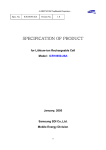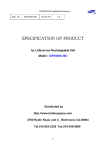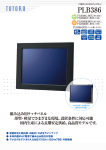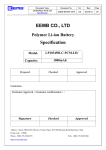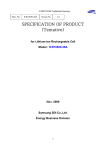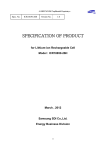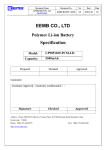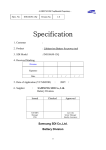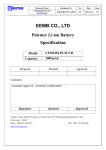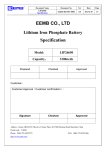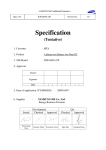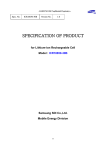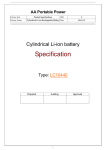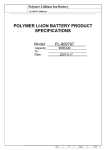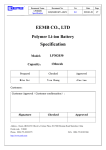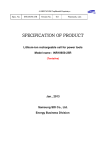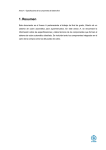Download SPECIFICATION OF PRODUCT
Transcript
SPECIFICATION OF PRODUCT for Lithium-ion Rechargeable Cell Model :LC10440 300mAh 2.0 Outline Dimensions 1.0 Nominal Specifications Item Specification Model LC10440 Nominal Capacity(0.2C5A) 300 mAh Nominal Voltage 3.70V Charging Voltage 4.2V Discharge Cut-off Voltage 2.75V Max. Charge Current 1 C5A Max. Discharge Current 1.5 C5A Cell Dimension Diameter 10±0.3 mm Height 44±0.3 mm Cell Weight(Approx.) Operating Temperature Max 44mm 22g Initial internal impedance Max, at 1000Hz.) Charging Current (CC/CV) Max10mm ≤120mΩ (Charged) Rapid charge 0.5 C5A×4hrs Standard charge 0.2 C5A×8hrs. Charge 0℃~60℃(32oF~113oF) Discharge “-20℃~75℃(-4oF~140oF) Storage “-20℃~45℃(-4oF~113oF) 3.0 Characteristics Drawing discharging curve at different temperature 不同温度充放电曲线 4.4 4.2 1C 4.0 4.0 3.8 0.5C 3.8 3.6 60℃ 3.4 40℃ 15℃ 3.2 0℃ 3.0 -20℃ 3.6 3.4 Capacity Ratio(%) 4.4 Charge 4.2 Voltage(V) cycle Characteristics 循环寿命曲线 120 120 100 0.2C 100 80 80 0.5C 60 60 40 40 20 20 3.2 25℃ 3.0 0.5C Discharge 2.8 0 20 40 60 80 100 Discharge Capacity Percent (%) 2.8 120 0 0 100 200 300 Cycle No. 400 0 500 4. Appearance There shall be no such defects as scratch, rust, discoloration, leakage which may adversely affect commercial value of the cell. 5. Standard Test Conditions 5.1 Environmental Conditions Unless otherwise specified, all tests stated in this specification are conducted at temperature 25±5℃ and humidity 65±20% 5.2 Measuring Equipment (1) Ammeter and Voltmeter:The ammeter and voltmeter should have an accuracy of the grade 0.5 or higher. (2) Slide caliper:The slide caliper should have 0.01 mm scale. (3) Impedance meter:The impedance meter with AC 1kHz should be used. 6. Characteristics 6.1 Standard Charge This "Standard Charge" means charging the cell with charge current voltage 4.2V at 25℃ for 3hours. 0.2C 5A and constant 6.2 Standard Discharge Capacity The standard discharge capacity is the initial discharge capacity of the cell, which is measured with discharge current of 0.2C5A with 2.75V cut-off at 25℃ within 1hour after the standard charge. NO. Item Relative Capacity Test Method A)0.2C5A≥100% Discharge B)0.5C5A≥95% 6.2.1 Rate C)1.0C5A≥90% Capabilities D)2.0C5A≥80% Temperature Dependence 6.2.2 of Discharge Capacity 6.2.3 Cycle Life Storage 6.2.4 Characterist ics A)60ºC≥95% B)0ºC≥85% C)-10ºC≥70% D)-20ºC≥60% Discharge capacity is measured with the various currents in under table and 2.75V cut-off after the standard charge. Capacity comparison at each temperature, measured with discharge constant current 0.2C5A and 2.75V cut-off after the standard charge . Each cycle is an interval between the charge (charge current 0.5C5A) with 2.5h or0.05C cut-off and the discharge (discharge current ≥80% 0.5C5A) with 2.75V cut-off.Capacity after 299cycles and plus 1 day, measured under the same condition. Capacity after storage for 30days at 25℃ Capacity retention(after measured with discharge current 0.2C5A with the storage)≥85% 2.75V cut-off at 25℃. 7 Safety No. Item Criteria 7.1 Overcharge Test No fire, and no explosion. Test method: To charge the standard charged cell with 5V and 3C5A at 25℃ for 2.5 hours. 7.2 Reverse Charge Test No fire, and no explosion. To charge the standard charged cell with charge current 1C5A By –5V for 2.5 hours. 7.3 External Shortcircuit Test No fire, and no explosion. Test method: To short-circuit the standard charged cell by connecting positive and negative terminal by less than 50m Ωwire for 3hours. Heating Test No fire, and no explosion. To heat up the standard charged cell at heating rate 5℃ per minute up to 130℃ and keep the cell in oven for 60 minutes. 7.4 Test Method 8. Mechanical Characteristics No. Item 8.1 Vibration Test 8.2 Drop Test Criteria Test method No leakage Cell(as of shipment) is vibrated along 2 mutually perpendicular axes with total excursion of 1.6mm and with frequency cycling between 10Hz and 55Hz by 1Hz/min. No leakage Cell(as of shipment or full charged) drop onto the oak-board (thickness: 30mm) from 1.5m height at a random direction 6 times. 9. Warranty BatteryCom will be responsible for replacing the cell against defects or poor workmanship for 15months from the date of shipping. Any other problem caused by malfunction of the equipment or mix-use of the cell is not under this warranty.The warranty set forth in proper using and handling conditions described above and excludes in the case of a defect which is not related to manufacturing of the cell. 10. Others 10.1 Storage for a long time If the cell is kept for a long time(3months or more), It is strongly recommended that the cell is preserved at dry and low-temperature. 10.2 Other Any matters that specifications does not have, should be conferred with between the both parties. 10.3 PTC Specification PTC Specification (in the Cell) Item Hold Current Resistance Power Dissipation Resistance After Trip Spec. 2.7A 9~18mΩ Max. 2.5W Max. 33mΩ 11. Packing Proper Use and Handling of Lithium Ion Cells See before using lithium-ion cell Supplied by BatteryCom Battery Co., Ltd. 1. General This document has been prepared to describe the appropriate cautions and prohibitions, which the customer should take or employ when the customer uses and handles the lithium ion cell to be manufactured and supplied by BatteryCom Battery Co., Ltd., in order to obtain optimum performance and safety. 2. Charging 2.1 Charging current Charging current should be less than maximum charge current specified in the product specification. 2.2 Charging voltage Charging should be done by voltage less than that specified in the product specification. 2.3 Charging time Continuous charging under appropriate voltage does not cause any loss of characteristics. However, the charge timer is recommended to be installed from a safety consideration, which shuts off further charging at time specified in the product specification. 2.4 Charging temperature The cell should be charged within a range of specified temperatures in the product specification. 2.5 Reverse charging The cell should be connected, confirming that its poles are correctly aligned. Inverse charging should be strictly prohibited. If the cell is connected improperly, it may be damaged. 3. Discharging 3.1 Discharging 3.1.1 The cell should be discharged at less than maximum discharge current specified in the product specification. 3.2 Discharging temperature 3.2.1 The cell should be discharged within a range of temperatures specified in the product specification. 3.2.2 Otherwise, it may cause loss of characteristics. 3.3 Over-discharging 3.3.1 The system should equip with a device to prevent further discharging exceeding discharging cut-off voltage specified in the product specification.(over-discharging) 3.3.2 Over-discharging may cause loss of performance, characteristics, of battery function. 3.3.3 Over-discharging may occur by self-discharge if the battery is left for a very long time without any use. 3.3.4 The charger should equip with a device to detect cell voltage and to determine recharging procedures. 4. Storage 4.1 Storage conditions 4.1.1 The cell should be stored within a range of temperatures specified in the product specification. 4.1.2 Otherwise, it may cause loss of characteristics, leakage and/or rust. 4.2 Long-term storage 4.2.1 The cell should be used within a short period after charging because long-term storage may cause loss of capacity by self-discharging. 4.2.2 If long-term storage is necessary, the cell should be stored at lower voltage within a range specified in the product specification, becausestorage at higher voltage may cause loss of characteristics. 5. Cycle life 5.1 Cycle life performance 5.1.1 The cell can be charged/discharged repeatedly up to times specified in the produce specification with a certain level of capacity also specified in the product specification. 5.1.2 Cycle life may be determined by conditions of charging, discharging,operating temperature and/or storage. 6. Design of System 6.1 Connection between the cell and the battery 6.1.1 The cell should not be soldered directly with leads. Namely, the cell should be welded with leads on its terminal and then be soldered with wire or leads to soldered lead. 6.1.2 Otherwise, it may cause damage of component, such as separator and insulator, by heat generation. 6.2 Positioning the battery in the System 6.2.1 The battery should be positioned as possible as far from heat sources and high temperature components. 6.2.2 Otherwise, it may cause loss of characteristics. 6.3 Mechanical shock protection of the battery 6.3.1 The battery should equip with appropriate shock absorbers in order to minimize shock. 6.3.2 Otherwise, it may cause shape distortion, leakage, heat generation and/or rupture. 6.4 Short-circuit protection of the cell 6.4.1 The cell equips with an insulating sleeve to protect short-circuit which may occur during transportation, battery assembly and /or system operation. 6.4.2 If the cell sleeve is damaged by some cause such as outside impact,it may cause short-circuit with some wiring inside the battery. 6.5 Connection between the battery and charger/system 6.5.1 The battery should be designed to be connected only to the specified charger and system. 6.5.2 A reverse connection of the battery, even in the specified system,should be avoided by employing special battery design such as a special terminals. 7. Battery Pack Assembly 7.1 Prohibition of usage of damaged cell 7.1.1 The cell should be inspected visually before battery assembly. 7.1.2 The cell should not be used if sleeve-damage, can-distorsion and/or electrolyte-smell is detected. 7.2 Terminals handling 7.2.1 Excessive force on the negative terminal should be avoided when external lead is welled. 7.3 Transportation 7.3.1 If the cell is necessary to transported to order place, such as the battery manufacturer, careful precautions should be taken to avoid damage of cell. 8. Others 8.1 Disassembly 8.1.1 The cell should not be dismantled from the battery pack. 8.1.2 Internal short-circuit caused by disassembly may lead to heat generation and/or venting. 8.1.3 When the electrolyte is coming in contact with the skin or eyes,flush immediately with fresh water and seek medical advice. 8.2 Short-circuiting 8.2.1 Short-circuit results in very high current which leads to heat generation. 8.2.3 An appropriate circuitry should be employed to protect accidental shortcircuiting. 8.3 Incineration 8.3.1 Incinerating and disposing of the cell in fire are strictly prohibited,because it may cause rupture. 8.4 Immersion 8.4.1 Soaking the cell in water is strictly prohibited, because it may cause melt of components to damaged to functions. 8.5 Mixing use 8.5.1 Different types of cell, or same types but different manufacturer's cell may lead to cell rupture or damage to system due to the different characteristics of cell. 8.6 Battery exchange 8.6.1 Although the cell contains no environmentally hazardous component,such as lead or cadmium. the battery should be disposed according to the local regulations when it is disposed. 8.6.2 The cell should be disposed with a discharged state to avoid heat generation by an inadvertent short-circuit. 8.7 Caution - The Battery used in this device may present a risk of fire or chemical burn if mistreated. Do not disassemble, heat above 100℃ or incinerate. Replace battery with BatteryCom battery only. Use of another battery may present a risk of fire or explosion. Dispose of used battery promptly. Keep away from children. Do not disassemble and do not dispose of in fire. 8.8 Warning – Attached Handling Precaution and Prohibitions of Lithium Ion & Lithium Ion Polymer Rechargeable Cells and Batteries Inaccurate handling of lithium ion and lithium ion polymer rechargeable battery may cause leakage,heat,smoke, an explosion, or fire. This could cause deterioration of performance or failure. Please be sure to follow instructions carefully. 1.1 Storage Store the battery at low temperature (below 20℃ is recommended), low humidity, no dust and no corrosive gas atmosphere. 1.2 Safety precaution and prohibitions To assure product safety, describe the following precautions in the instruction manual of the application. [ Danger!] ■ Electrical misusage Use dedicated charger. Use or charge the battery only in the dedicated application. Don't charge the battery by an electric outlet directly or a cigarette lighter charger. Don't charge the battery reversely. ■ Environmental misusage Don't leave the battery near the fire or a heated source. Don't throw the battery into the fire. Don't leave, charge or use the battery in a car or similar place where inside of temperature may be over 60℃. Don't immerse, throw, wet the battery in water / seawater. ■ others Don't fold the battery cased with laminated film such as pouch and Polymer. keys, necklaces, hairpins, coins, or screws. Don't short circuit (+) and (-) terminals with metallic object intentionally. Don't pierce the battery with a sharp object such as a needle, screw drivers. Don't heat partial area of the battery with heated objects such as soldering iron. Don't hit with heavy objects such as a hammer, weight. Don't step on the battery and throw or drop the battery on the hard floor to avoid mechanical shock. Don't disassemble the battery or modify the battery design including electric circuit. Don't solder on the battery directly. Don't use seriously scared or deformed battery. Don't put the battery into a microwave oven, dryer ,or high-pressure container. Don't use or assemble the battery with other makers' batteries, different types and/or models of batteries such as dry batteries, nickel-metal hydride batteries, or nickelcadmium batteries. Don't use or assemble old and new batteries together. [ Warning! ] Stop charging the battery if charging isn't completed within the specified time. Stop using the battery if the battery becomes abnormally hot, order, discoloration, deformation, or abnormal conditions is detected during use, charge, or storage. Keep away from fire immediately when leakage or foul odors are detected. If liquid leaks onto your skin or cloths, wash well with fresh water immediately. If liquid leaking from the battery gets into your eyes, don't rub your eyes and wash them with clean water and go to see a doctor immediately. If the terminals of the battery become dirty, wipe with a dry cloth before using the battery. The battery can be used within the following temperature ranges. Don't exceed these ranges. Charge temperature ranges : 0℃~ 45℃ Discharge Temperature ranges : -20℃ ~ 60℃ Store the battery at temperature below 60℃ Cover terminals with proper insulating tape before disposal. [ Caution! ] ■ Electrical misusage Battery must be charge with constant current-constant voltage (CC/CV). Charge current must be controlled by specified value in Cell specification. Cut-off Voltage of charging must be 4.2V. Charger must stop charging battery by detecting either charging time or current specified in Cell’s specification. Discharge current must be controlled by specified value in Cell’s specification. Cut-off Voltage of discharging must be over 2.5V. ■ others Keep the battery away from babies and children to avoid any accidents such as swallow. If younger children use the battery, their guardians should explain the proper handling method and precaution before using. Before using the battery, be sure to read the user's manual and precaution of it's handling. Before using charger, be sure to read the user's manual of the charger. Before installing and removing the battery from application, be sure to read user's manual of the application. Replace the battery when using time of battery becomes much shorter than usual. Cover terminals with insulating tape before proper disposal. If the battery is needed to be stored for an long period, battery should be removed from the application and stored in a place where humidity and temperature are low. While the battery is charged, used and stored, keep it away from object materials with static electric chargers. Safety Handling Procedure for the Transporter ■ Quarantine : Packages that are crushed, punctured or torn open to reveal contents should not be transported. Such packages should be isolated until the shipper has been consulted,provided instructions and, if appropriate, arranged to have the product inspected and repacked. ■ Spilled Product : In the event that damage to packaging results in the release of cells or batteries,the spilled products should be promptly collected and segregated and the shipper should be contacted for instructions. Design of positioning the battery pack in application and charger To prevent the deterioration of the battery performance caused by heat, battery shall be positioned away from the area where heat is generated in the application and the charger. Design of the Battery Pack Be sure adopting proper safe device such as PTC specified type or model in Cell Specification. If you intend to adopt different safety device which is not specified in Cell Specification, please contact BatteryCom to investigate any potential safety problem. Be sure designing 2nd protective devices such as PTC & PCM at the same time to protect Cell just in case one protective device is fault.











